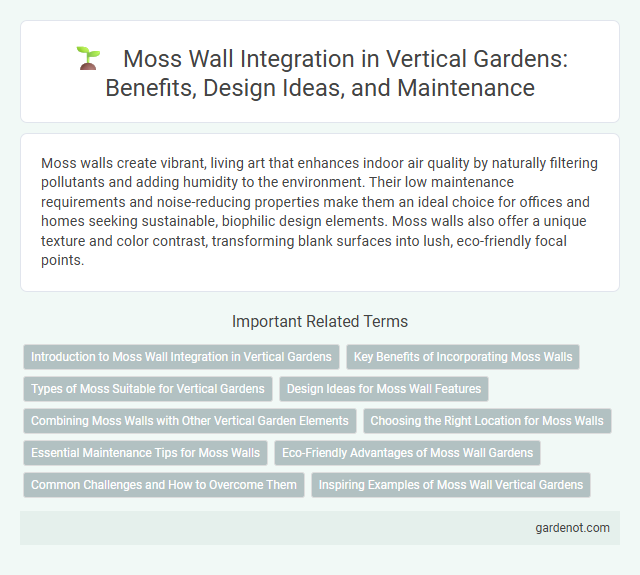Moss walls create vibrant, living art that enhances indoor air quality by naturally filtering pollutants and adding humidity to the environment. Their low maintenance requirements and noise-reducing properties make them an ideal choice for offices and homes seeking sustainable, biophilic design elements. Moss walls also offer a unique texture and color contrast, transforming blank surfaces into lush, eco-friendly focal points.
Introduction to Moss Wall Integration in Vertical Gardens
Moss walls enhance vertical gardens by offering a low-maintenance, air-purifying natural element that thrives in low-light conditions. Integrating moss walls improves indoor air quality and adds vibrant texture without requiring soil or frequent watering. This sustainable option supports biodiversity and creates a calming green environment ideal for residential and commercial spaces.
Key Benefits of Incorporating Moss Walls
Moss walls provide natural air purification by absorbing pollutants and releasing oxygen, enhancing indoor air quality. Their high humidity retention helps regulate moisture levels, reducing the risk of mold and improving overall indoor comfort. Moss walls also require minimal maintenance, thrive in low light, and add a vibrant, natural aesthetic that promotes wellness and reduces stress.
Types of Moss Suitable for Vertical Gardens
Sheet moss, cushion moss, and mood moss are popular types for vertical gardens due to their adaptability and low maintenance. Sheet moss offers a flat, carpet-like texture that thrives in shaded environments, while cushion moss provides a dense, cushiony appearance ideal for vertical surfaces. Mood moss is favored for its vibrant green color and ability to retain moisture, enhancing the vertical garden's aesthetic and health.
Design Ideas for Moss Wall Features
Moss wall features offer versatile design ideas that enhance indoor and outdoor spaces with natural texture and vibrant greenery, requiring minimal maintenance. Integrating various moss types such as cushion, sheet, or reindeer moss creates dynamic visual contrasts and adds depth to vertical garden installations. Combining moss walls with ambient LED lighting and natural wood frames amplifies aesthetic appeal while promoting air purification and acoustic benefits.
Combining Moss Walls with Other Vertical Garden Elements
Moss walls create a soft, textured backdrop that enhances the visual appeal and air-purifying benefits of vertical gardens. Integrating moss walls with living plants such as ferns and succulents introduces diverse textures and thriving ecosystems, while incorporating wood or metal framework provides both structural support and modern design contrast. This combination not only maximizes greenery coverage but also optimizes humidity regulation and acoustic insulation within indoor spaces.
Choosing the Right Location for Moss Walls
Selecting an ideal location for a moss wall requires considering factors such as indirect light, consistent humidity, and moderate temperature to promote healthy moss growth. Avoid direct sunlight and areas with drastic temperature fluctuations, as these conditions can cause moss to dry out or deteriorate. Ensuring proper air circulation without exposure to harsh drafts helps maintain moisture levels, enhancing the longevity and vibrancy of the moss wall.
Essential Maintenance Tips for Moss Walls
Regular misting and maintaining humidity levels between 40-60% are essential for vibrant moss walls. Avoid direct sunlight and ensure proper airflow to prevent mold growth while promoting healthy moss development. Periodically remove dust and debris with a soft brush to maintain the moss texture and color intensity.
Eco-Friendly Advantages of Moss Wall Gardens
Moss wall gardens offer exceptional eco-friendly advantages by improving indoor air quality through natural air purification and humidity regulation. Their low-maintenance nature requires minimal water and no harmful chemicals, reducing environmental impact compared to traditional plants. These vertical green installations also contribute to energy efficiency by enhancing building insulation and lowering heating and cooling costs.
Common Challenges and How to Overcome Them
Moss walls often face common challenges such as humidity control, lighting requirements, and maintenance to prevent mold growth. Proper ventilation and selecting suitable moss species that thrive in indoor environments help maintain optimal moisture levels. Regular monitoring and gentle cleaning techniques ensure the longevity and vibrancy of a vertical moss garden.
Inspiring Examples of Moss Wall Vertical Gardens
Moss wall vertical gardens transform interior spaces with lush, low-maintenance greenery that improves air quality and acoustics. Notable examples include the Moss Living installation in New York, which integrates various moss species into artistic patterns, creating a vibrant, natural focal point. These living walls showcase sustainable design by harnessing moss's ability to thrive without soil, requiring minimal water and light while enhancing urban environments.
Moss wall Infographic

 gardenot.com
gardenot.com